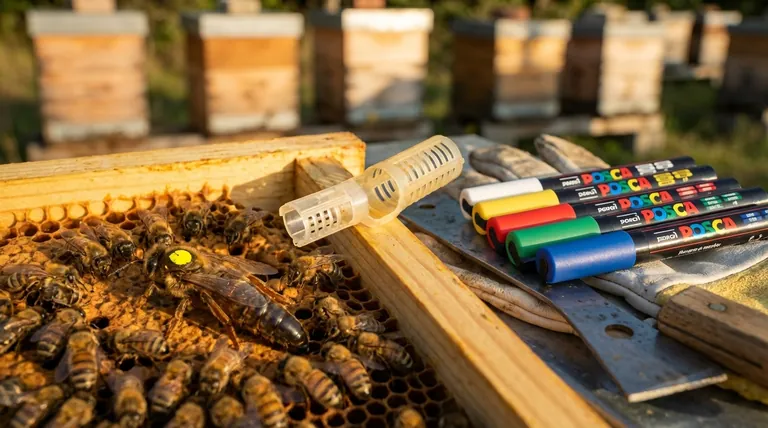The international color code for marking queen bees follows a five-year rotation based on the last digit of the year the queen was hatched and mated. The system assigns White for years ending in 1 or 6, Yellow for 2 or 7, Red for 3 or 8, Green for 4 or 9, and Blue for 0 or 5. This allows a beekeeper to determine a queen's age at a glance.
This standardized system is not just about locating the queen in a hive of thousands. It's a critical management tool that allows you to instantly assess her age—the most important predictor of a colony's productivity, health, and future success.

The Purpose Behind Marking a Queen
Marking the queen bee is a fundamental practice in modern beekeeping for several key reasons. It elevates hive management from reactive to proactive.
Instantly Assess Queen Age
A queen's egg-laying prowess typically peaks in her first or second year and declines thereafter. Knowing her age helps you anticipate this decline and decide when to replace her to maintain a strong, productive colony.
Simplify Hive Inspections
Finding one specific bee among 50,000 others can be a time-consuming and disruptive task. A brightly colored dot on her thorax makes the queen easy to spot, significantly reducing inspection time and stress on the colony.
Confirm the Hive is "Queenright"
A quick glance that confirms the marked queen is present and laying tells you the hive is "queenright" and stable. If she is missing, you know immediately that you need to investigate whether she has been replaced or if the colony is in trouble.
The International Color Code Explained
The system is designed to be simple and universal, using five colors in a repeating cycle. Since a queen bee's productive lifespan is typically less than five years, this rotation is sufficient to avoid any confusion about her age.
The 5-Year Color Rotation
The sequence of colors is always the same, tied to the final digit of the year.
- White: Years ending in 1 or 6
- Yellow: Years ending in 2 or 7
- Red: Years ending in 3 or 8
- Green: Years ending in 4 or 9
- Blue: Years ending in 0 or 5
A Mnemonic to Remember the Order
A common and effective way to remember the sequence is the phrase "Will You Raise Good Bees."
The first letter of each word corresponds to the color for years ending in 1 through 5: White (1), Yellow (2), Red (3), Green (4), Blue (5).
Practical Considerations and Pitfalls
While marking is a high-value practice, it's essential to understand the potential downsides and best practices.
The Risk of Incorrect Application
The mark must be a small, neat dot placed on the middle of the queen's thorax (her back, between the wing joints). Paint on her head, wings, or abdomen can harm her or interfere with her natural functions.
Potential for Queen Rejection
Handling a queen introduces a foreign scent. There is a small but real risk that the colony may see her as an intruder upon her return and attempt to kill and replace her, an act known as supersedure.
Marks Can Fade or Wear Off
Over time, the paint dot can be worn down by the other bees in the hive. While modern marking pens are quite durable, it's possible for a mark to become difficult to see on an older queen.
How to Apply This to Your Hive Management
Your management decisions can be guided directly by the color you see during an inspection.
- If your primary focus is peak performance: A queen with last year's color is likely in her prime; a queen with a two-year-old color should be monitored for declining laying patterns and considered for replacement.
- If your primary focus is identifying hive events: Finding an unmarked queen in a hive that previously had a marked one is definitive proof that a swarm or supersedure event has occurred.
- If your primary focus is efficiency: Simply using the mark to find the queen quickly will reduce the time you spend on each inspection, allowing you to manage more colonies with less disturbance.
Understanding this simple color code transforms you from a passive observer into a truly informed and effective beekeeper.
Summary Table:
| Year Ending In | Queen Marking Color |
|---|---|
| 1 or 6 | White |
| 2 or 7 | Yellow |
| 3 or 8 | Red |
| 4 or 9 | Green |
| 0 or 5 | Blue |
Ready to Elevate Your Apiary Management?
As a commercial beekeeper or equipment distributor, precise hive management is the key to your productivity and profitability. The right tools make all the difference.
HONESTBEE is your trusted wholesale partner for professional beekeeping supplies. We provide the durable, reliable equipment—including queen marking kits—that commercial operations and distributors depend on to maintain healthy, high-yielding colonies.
Let us help you optimize your operation. Contact our wholesale team today to discuss your supply needs and discover how our products can support your success.
Visual Guide

Related Products
- Queen Bee Marking Pen POSCA Queen Marking Pens for Beekeeping Bee Markers
- Queen Bee Marking Pen UNI Medium Point for Queen and Bee Marking
- Queen Bee Marking Tube Cage Bottle Catcher Holder with Clear Plastic Plunger Marker
- Professional Engraved Round Hive Number Tags for Beekeeping
- Professional Galvanized Hive Strap with Secure Locking Buckle for Beekeeping
People Also Ask
- Where is the queen bee typically marked? A Guide to Safe & Effective Queen Identification
- What are the benefits of learning to mark your own queen bees? Boost Your Apiary's Efficiency and Confidence
- What is the purpose of a queen marking pen in beekeeping? Essential for Efficient Hive Management
- What are the advantages of marking a queen bee? Achieve Precision and Confidence in Hive Management
- What type of markers are commonly used for marking Queen bees? Choose the Safe, Non-Toxic Standard



















